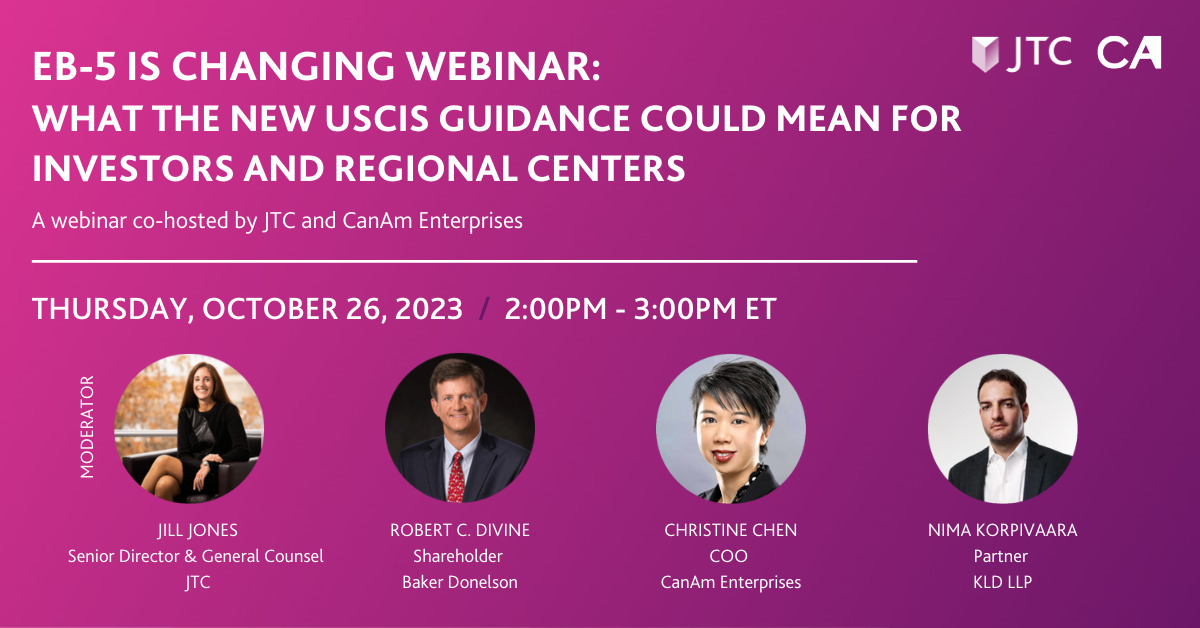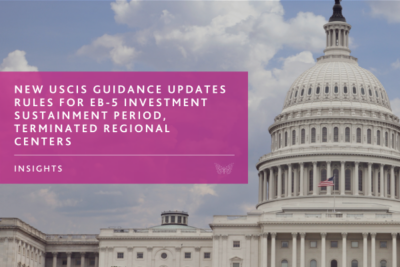Published on IIUSA Regional Center Business Journal
April, 2020
By Walter S. Gindin
The EB-5 Program changed significantly on November 21, 2019 when the Department of Homeland Security’s (“DHS”) final EB-5 Modernization Rule (the “Final Rule”) took effect. The Final Rule made several major revisions to the EB-5 regulations for the first time since 1993, most notably, increasing minimum investment amounts and tightening the procedures and certain of the criteria for designating targeted employment areas (“TEA”). Barring any superseding legislative reforms, the regulatory changes occasioned by the Final Rule are here to stay. It is therefore incumbent that all EB-5 stakeholders understand and adapt to the new regulatory landscape if the EB-5 Program is to continue its mission of facilitating economic development and job creation throughout the United States. This article examines some of the adjustments that regional centers, in particular, may need to make to their project selection and offering practices in light of the changes applicable to the determination and designation of TEAs.
Changes to TEA Standards
The Final Rule made several prominent changes to the process and certain of the criteria for designating TEAs.
From a process standpoint, the Final Rule indicates that for EB-5 applications and petitions filed on or after November 21, 2019, USCIS will directly review and determine the designation of TEAs and will no longer defer to TEA designations made by state and local governments. USCIS also indicated in its response to comments to the Final Rule that it does not intend to establish a separate application or process for obtaining TEA designations from USCIS prior to filing EB-5 applications or petitions and will not issue separate TEA designation letters for areas of high unemployment. Rather, USCIS has stated that it intends to make TEA determinations as part of the existing adjudication process.
Substantively, the Final Rule did not make changes to the regulatory definition of “rural area” and also maintained the ability to demonstrate that the entire Metropolitan Statistical Area (“MSA”) and a specific county within a MSA qualifies as a TEA. The Final Rule did add cities or towns with a population of 20,000 or more which is outside a MSA as a distinct TEA designation criteria.
The Final Rule also made fundamental changes to the scope of high unemployment designations for sub-county regions. Prior to the Final Rule, it was possible to aggregate any number of contiguous census tracts (inclusive of the project census tract) to reach the requisite average unemployment rate threshold of 150% of the national average unemployment rate. The Final Rule limited the geographic scope of a sub-county area to the census tract or contiguous census tract(s) in which the project is located/principally doing business, and any or all census tracts directly adjacent to such census tract(s), provided that the weighted average of the unemployment rate for the subdivision (that is, the area comprised of multiple census tracts), based on the labor force employment measure for each census tract, is at least 150% of the national average unemployment rate.
The foregoing procedural and substantive changes to TEA designations are likely to impact regional centers’ operations in a number of ways as discussed below.
Impacts on Project Selection Process
The substantive changes to the TEA criteria have the potential to limit the number of projects that may be eligible for TEA designation. For example, certain projects that must rely on the more restrictive standards for census tract aggregation to meet the unemployment threshold are particularly susceptible to not being eligible for TEA designation. The immediate impact of such tightening of standards is that regional center operators may have to turn down many more projects that otherwise meet their financial and immigration suitability standards simply because the projects are not located in TEAs (or located in “close call” TEAs) and a $1.8 million-per-investor raise is not feasible.
At the same time, regional center operators should be wary of pursuing projects that may have certain shortcomings from a financial and/or immigration suitability standpoint simply because the projects are “shoe-ins” for TEA designation under the new regulatory criteria. Sound underwriting and due diligence practices on the part of regional centers are more important than ever, and prospective investors too must pay even greater attention to the fundamentals of each project and the underlying rationale for a regional center’s sponsorship of that project.
Working Closely with Experienced EB-5 Economists
The regulatory changes to the TEA designation standards have increased the importance of EB-5 economists. Under the old regime, regional centers and/or project sponsors could manage by simply providing a state agency an address or a general location of a project and receive a TEA designation letter in a matter of hours in some cases. That is no longer the case. In fact, this author previously reached out to a state agency to inquire whether it would be willing to merely provide a supplemental opinion to support a third-party TEA analysis (understanding that USCIS will not give deference to any state letter on its own), and received a response akin to “sorry, we’re out of it.”
Regional centers should therefore work closely with experienced EB-5 economists to assess TEA eligibility for a particular project. This involves all parties understanding and agreeing on the actual regulatory requirements – that is, everyone should be on the same page as to what the rules actually say. At the same time, all parties must be cognizant that the regulatory changes are brand new and there is no history of USCIS adjudications under this new framework that stakeholders can rely on for reference and additional guidance. As such, the parties should explore all avenues of establishing TEA eligibility, for example, by assessing whether the entire MSA, county, city or town independently qualify, and whether and to what extent a grouping of census tracts qualify. Presenting USCIS with multiple TEA designation alternatives could increase the chances that USCIS approves the TEA eligibility of a project based on at least one of those alternatives.
Additionally, while it is important that EB-5 economists provide a reasonable and credible framework for their TEA analyses, it is also necessary to bear in mind that EB-5 economists, just like every other stakeholder, are also working within a brand new regulatory framework and are providing analyses, though based on their wealth of experience, in an environment where USCIS has yet to meaningfully opine on the reasonableness and/or credibility of a particular approach as applied to the changes introduced by the Final Rule. Regional centers should understand that even though the regulatory text of the new TEA regulations may appear straightforward, there still exist uncertainties surrounding USCIS’s interpretation and implementation of any such regulatory criteria, and these uncertainties should be prominently disclosed as described below.
Disclosures
EB-5 offerings are typically accompanied by a memorandum and other supporting materials that contain, among other things, material disclosures about the EB-5 Program and a particular capital investment. EB-5 offerings issued (or amended, as applicable) after November 21, 2019 should contain robust disclosures about the regulatory changes contained in the Final Rule. Because it cannot be assumed that every investor is familiar with such changes, it may be good practice to expressly call out that the offering is being made to prospective investors under the new regulatory regime.
With regard to TEA designations, offering memoranda should disclose the new/changed procedural and substantive criteria, in particular, the fact that USCIS will now have exclusive jurisdiction over TEA determinations. Equally important are disclosures informing investors that none of the regional center, new commercial enterprise, or any affiliated entity can predict how USCIS will interpret and apply the new TEA criteria or provide any assurance that USCIS will approve the underlying TEA designation analysis. It is also important to disclose that a regional center will not know whether USCIS approves the actual TEA designation for a particular project until USCIS adjudicates either the I-924 exemplar or a related I-526 Petition filed by an investor, which adjudications can take several years to complete.
While the foregoing are not meant to be an exclusive list of potential disclosures (TEA-related or otherwise), the overarching goal is to provide prospective investors with sufficient information to make an informed decision (in consultation with experienced counsel and other consultants) about whether a particular investment is likely to meet their financial and immigration needs.
Different Rules, Same Principles
It is important to recognize that while some major the rules of the EB-5 Program have changed, its fundamentals and principles have not. Regional centers must continue to source quality projects with strong underlying fundamentals. Similarly, investors should continue performing thorough screening and due diligence on each regional center-sponsored project to maximize the probability of achieving all financial and immigration benefits under the EB-5 Program. And despite some of the unknowns in how USCIS could interpret and implement the new regulations, for as long as they exist, it is imperative that all EB-5 stakeholders continue to move the EB-5 Program forward.
CanAm Enterprises, with over three decades of experience promoting immigration-linked investments in the US and Canada, has a demonstrated track record of success. With over 60 financed projects and $3 billion in raised EB-5 investments, CanAm has earned a reputation for credibility and trust. To date, CanAm has repaid more than $2.26 billion in EB-5 capital from over 4,530 families. CanAm manages several USCIS-designated regional centers that stretch across multiple states. For more information, please visit www.canamenterprises.com.





